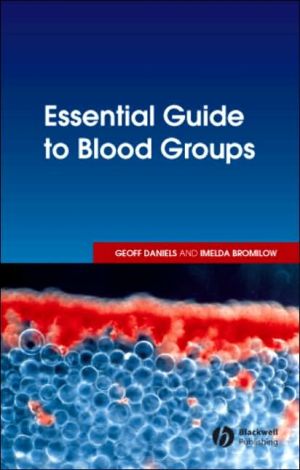

 |

|

Sold Out
Book Categories |
Abbreviations ix
An introduction to blood groups 1
What is a blood group? 1
Blood group antibodies 2
Clinical importance of blood groups 3
Biological importance of blood groups 3
Blood group systems 4
Blood group terminology and classification 5
Techniques used in blood grouping 7
Factors affecting antigen-antibody reactions 7
Temperature 7
Time and ionic strength 8
pH 8
Antigen density 8
Stages of haemagglutination reactions 9
Direct agglutination 10
Indirect agglutination 11
Enzyme techniques 11
Antiglobulin tests 12
Elution techniques 17
Automation of test procedures 17
Flow cytometry 18
Molecular blood group genotyping 19
The ABO blood groups 20
Introduction 20
ABO antigens, antibodies, and inheritance 20
A[subscript 1] and A[subscript 2] 21
Antigen, phenotype, and gene frequencies 22
ABO antibodies 23
The importance of the ABO system to transfusion and transplantation medicine 24
The biochemical nature of the ABO antigens 25
Biosynthesis of the ABO antigens and ABO molecular genetics 26
H, the precursor of A and B 27
ABH secretion 28
H-deficient red cells 29
Further complexities 30
Acquired changes 31
Associations with disease and functional aspects 31
The Rh blood group system 33
Introduction - Rh, not rhesus 33
Haplotypes, genotypes, and phenotypes 34
Biochemistry and molecular genetics 35
D antigen (RH1) 36
Molecular basis of the D polymorphism 37
D variants 37
Clinical significance of anti-D 39
D testing 40
Prediction of RhD phenotype from fetal DNA 40
C, c, E, and e antigens (RH2, RH4, RH3, RH5) 41
Clinical significance of CcEe antibodies 41
Molecular basis of the C/c and E/e polymorphisms 41
Other Rh antigens 42
Compound antigens: ce, Ce, CE, cE (RH6, RH7, RH22, RH27) and G (RH12) 42
C[superscript w], C[superscript x], MAR (RH8, RH9, RH51) 42
VS, V (RH20, RH10) 43
Rh-deficient phenotypes - Rh[subscript null] and Rh[subscript mod] 43
Putative function of the Rh proteins and RhAG 43
Other blood groups 45
The Kell system 45
The Kell glycoprotein and the Kel gene 46
Kell-system antigens 46
Kell-system antibodies 47
K[subscript 0] phenotype 47
McLeod syndrome, McLeod phenotype, and Kx (XK1) antigen 47
The Duffy system 48
Fy[superscript a] (FY1) and Fy[superscript b] (FY2) 48
Anti-Fy[superscript a] and -Fy[superscript b] 49
Fy3 and Fy5 49
The Duffy glycoprotein, a receptor for chemokines 49
Duffy and malaria 49
The Kidd system 50
Jk[superscript a] (JK1) and Jk[superscript b] (JK2); anti-Jk[superscript a] and -Jk[superscript b] 50
Jk(a-b-) and Jk3 50
The Kidd glycoprotein is a urea transporter 51
The MNS system 51
M (MNS1) and N (MNS2); anti-M and -N 52
S (MNS3) and s (MNS4); anti-S and -s 52
S- s- U- phenotype and anti-U 52
Other MNS antigens and antibodies 53
The Diego system 53
Band 3, the red cell anion exchanger 53
Di[superscript a] (DI1) and Di[superscript b] (DI2); anti-Di[superscript a] and -Di[superscript b] 53
Wr[superscript a] (DI3) and Wr[superscript b] (DI4); anti-Wr[superscript a] and -Wr[superscript b] 54
Other Diego-system antigens 54
The Lewis system 55
Some other blood group systems 56
P 56
Lutheran 56
Yt 57
Xg 57
Scianna 57
Dombrock 57
Colton 57
Landsteiner-Wiener (LW) 57
Chido/Rodgers 57
Gerbich 58
Cromer 58
Knops 58
Indian 58
I 58
Antigens that do not belong to a blood group system 59
Clinical significance of blood group antibodies 60
Antibody production and structure 61
Factors affecting the clinical significance of antibodies 63
Antibody specificity 64
Haemolytic transfusion reactions 65
Intravascular red cell destruction 65
Extravascular red cell destruction 65
Haemolytic disease of the fetus and newborn 66
Cross-matching for infants under 4 months old 68
Autoantibodies 70
Tests to assess the potential significance of an antibody 70
Decision-making for transfusion 71
Quality assurance in immunohaematology 73
Achieving total quality 73
Frequency and specificity of control material 73
Quality requirements for safe transfusion practice 76
Checklist of critical control points 76
QC for molecular blood group testing 77
Trouble-shooting and problem-solving in the reference laboratory 78
ABO grouping 78
Rh grouping 78
Problems in antibody screening, identification, and cross-matching 78
Frequently asked questions 88
Recommended reading 95
Index 97
Login|Complaints|Blog|Games|Digital Media|Souls|Obituary|Contact Us|FAQ
CAN'T FIND WHAT YOU'RE LOOKING FOR? CLICK HERE!!! X
 You must be logged in to add to WishlistX
 This item is in your Wish ListX
 This item is in your CollectionBlood Groups
X
 This Item is in Your InventoryBlood Groups
X
 You must be logged in to review the productsX
 X
 X

Add Blood Groups, Essential Guide to Blood Groups is the only pocket sized guide to provide essential information on blood group systems. The main aim of the blood transfusion laboratory is to promote safe blood transfusion. The avoidance of errors, from samp, Blood Groups to the inventory that you are selling on WonderClubX
 X

Add Blood Groups, Essential Guide to Blood Groups is the only pocket sized guide to provide essential information on blood group systems. The main aim of the blood transfusion laboratory is to promote safe blood transfusion. The avoidance of errors, from samp, Blood Groups to your collection on WonderClub |